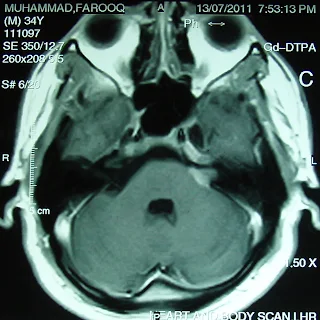Saturday, July 23, 2011
Ependymoma,complete resolution.
Case summary:
This, 26 years nice man from Karachi had undergone insertion of VP shunt on right side on November 22, 2010 on radio diagnosis of heterogeneous enhancing solid cum cystic mass in posterior fossa in fourth ventricle causing hydrocephalus. This was diagnosed when patient had presented with severe headache on and off associated with vomiting worst since last month and blurred vision since one month.
On referral, he had presented some improvement in headache and vomiting and significant improvement in blurring of vision. Clinical examination had revealed no obvious neurologic deficit. MRI brain spectroscopy had revealed markedly elevated Choline levels up to 399. Patient has referred us for the management with GKSRS. Risk of GKSRS explained all in Urdu along with requirement of strict follow up. These agreed upon wished to proceed. He had treatment with following prescription,
Target | Location | Prescription | Volume |
A | Ependymoma. | 12Gy @ 50% | 18.6 cm³ |
Multiple isocenters with 18, 14 & 8 mm collimator used in APS mode. He had discharged on tapering doses of Dexamethasone and advised follow up after 3 months
Oligodendroglioma, Anaplastic, WHO grade III. Good Control.
Acoustic Schwannoma 2yrs. Follow Up. after GKRS.
 |
This 32 years old gentleman from Lahore was a diagnosed case of left Acoustic Schwannoma.He presented with progressive left hearing loss since 10th June 09, left hemi facial numbness, mild headache , loss of taste and occasional imbalance since 20 days. Clinical examination revealed left hemi facial hypoesthesia and poor corneal reflex. MRI shows heterogeneously enhancing mass in left CPA. He was treated with marginal dose of 12.5 Gy at 50% isodose line to the target volume of 9.0 cc. Multiple isocenters with 14, 8 and 4 mm collimators were used in APS mode. He was discharged on tapering doses of Dexamethasone and advised for follow up images after 6 months. |
 |
F.up at one year shows 80% reduction in Tumor. |
 |
| F.Up at 2 yrs. Shows 90 % reduction in tumor. |
Subscribe to:
Comments (Atom)















